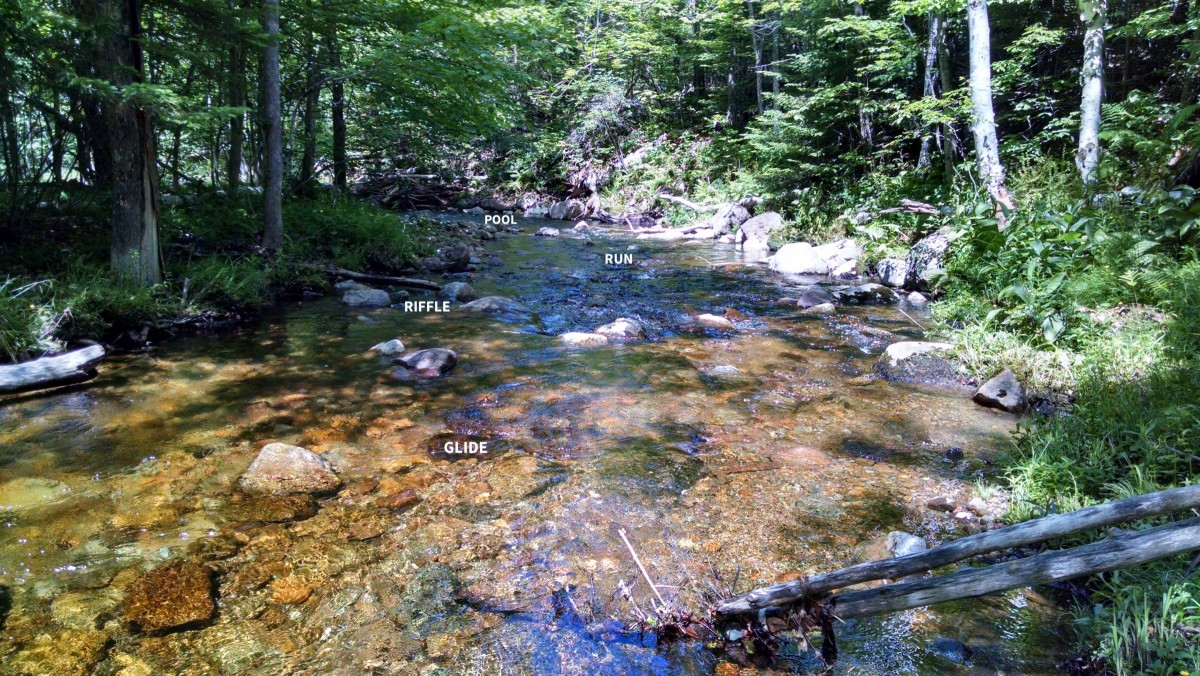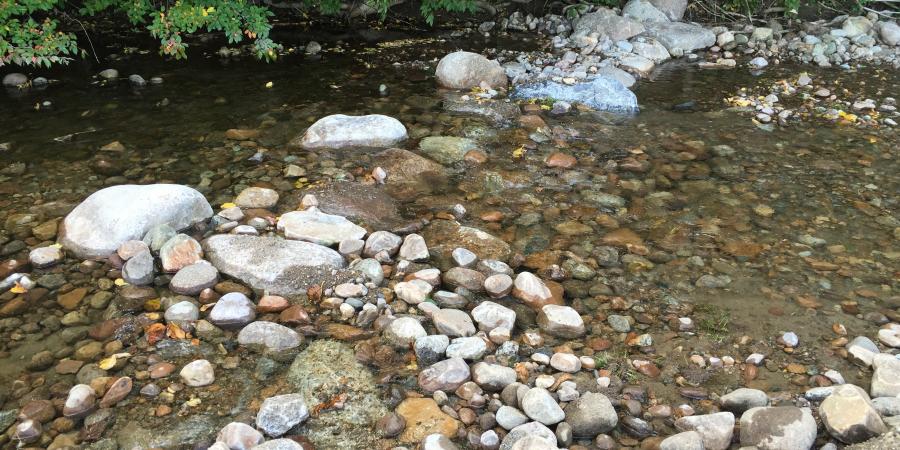If you've ever spent time along a stream of any size, you may have wondered about the alternating patterns of flat versus tumbling water - what river scientists refer to as features. What's behind that? Why isn't it all one continuous feature? And if you've been faced with the challenge of crossing a stream, finding the appropriate stream feature can help you cross safely with minimal effort. Or, knowing where those pools get deepest, might influence where you cast your line in search of a trophy trout.
Healthy streams have repeating features that maintain channel slope and stability. In a sinuous lower slope stream meandering across a valley floor – such as the East Branch in Keene Valley or the West Branch along River Road – riffles, runs, pools, and glides will appear in sequence. Higher slope streams tumbling down a hilly or mountainous grade follow a step-pool sequence – such as John's Brook in its higher elevations or Cascade Brook. In each case, these stream features interact with the bed, banks, and floodplain of a stream to create a network that supports wildlife habitat, oxygenates water, and continuously rebuilds stream form and function.
In most Ausable streams, riffles are dominated by larger cobble or boulders forming a single or short series of rib-like structures from bank to bank. Riffles are relatively shallow, and the slope of the water surface is steeper compared to the average water slope of the stream. Water moves faster over riffles even at low flow, removing fine sediments and oxygenating the stream. Riffles control the stream bed slope and elevation and they serve as a gateway and exit to pools in a meandering system. They also provide a good starting point if you are looking for a place to cross a stream. Runs follow riffles; they are deeper with a less turbulent water surface. Pools form on the outside bends of meanders between riffles; they also occur behind large protruding boulders in the channel or along the banks. Pools have a near-flat water surface (the product of a very low slope) and are much deeper than the stream's average depth. Low flows deposit sediment and cobble in pools and scour them away from riffles. In high flows, the opposite is true: as a result of increased sheer stress – the force exerted by water on the stream bed that increases in deeper areas – the pool is scoured and bed materials deposit on the riffle, rebuilding and reinforcing it. A glide is the section of the stream coming out of the pool, from deeper to shallower as it approaches the next riffle. River scientists often refer to the pool tail or the tailwater in reference to the tail-like surface water formation that marks the transition from glide to riffle.

Stream channels, their near riparian areas, wetlands, and floodplains are part of a network essential to ecosystem health. Streams transport water and sediment gathered from the surrounding watershed. They provide habitat for aquatic organisms including fish, amphibians, insects, birds, and plants. Features such as riffles and pools, runs and glides, sustain these diverse aquatic habitats and continuously reinforce stream function. In normal flows, small invertebrates, macrobenthic organisms, cling to rocks and coarse substrates in riffle areas, filtering food from and thriving in the oxygen-rich water. Fish rely on pools, taking advantage of the cover provided for feeding and resting and benefitting from the cooler water temperatures in these deeper waters. Indeed, within each pool, different aquatic species use varying water depths and locations within it, illustrating the enormous potential for diversity streams provide (Harman et al, 2012).
Support our river restoration work for clean water and healthy streams. Give with confidence today!
Taking the time to identify and measure stream features in healthy reaches of a river can help us assess and address problems in sections that are experiencing erosion, widening, or areas that seem less resilient. But understanding the sequence of features in your local stream will enhance your appreciation of its unique nature, experience its gradual changes, and help you enjoy its intricate and practical beauty.

To learn even more: "A Function-Based Framework for Stream Assessments and Restoration Projects" May 2012 by Will Harman, Rich Starr et. al., is searchable on the web. The framework provides a comprehensive approach for understanding streams and assessing and restoring stream form, function, and health.
Sign-up for our e-newsletter to get weekly updates on the latest stories from the Ausable River Association.


